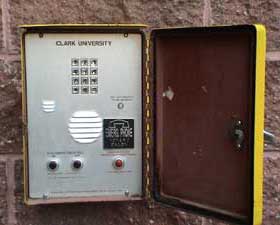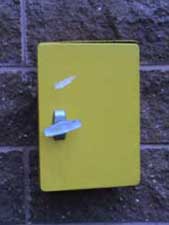Emergencies
- Biological
- Chemical Spills
- Electrical Shocks
- Explosion and Fire Emergencies
- Medical Emergencies
- Splashes
Biological spills are those than involve potentially hazardous microorganisms or possibly contaminated bodily fluids.
Cleaning up a biological spill step by step:
- Help anybody that might be contaminated by flushing the area splashed. The safety shower, eye wash unit, or the sink can be used for this purpose.
- Inform persons in the vicinity of the spill. Evacuate all nonessential personnel from the spill area, and post danger signs.
- Put on protective equipment. This includes a laboratory coat with long sleeves, tear-resistant gloves (wear two pairs), disposable shoe covers, and safety goggles.
- Cover spill with paper towels.
- Carefully pour a freshly prepared 1 to 10 dilution of household bleach. First bleach the edges and then the center areas. Avoid splashing.
- Let the spill soak for a minimum of 20 minutes.
- After 20 minutes clean the spill with fresh towels soaked in bleach or disinfectant.
- Bleached materials are disinfected and can go in the trash. Bleach cannot be autoclaved.
- Remove gloves one at the time by grasping the wrist end and pulling toward the fingers. The gloves should then come inside out.
- All contaminated protective equipment should be placed in another waste bag and autoclaved.
- Vigorously wash hands, arms, and shoe soles with lots of soap and water for at least one full minute.
- Report incident to laboratory supervisor and chemical safety officer: extension 7280 or 1-508-793-7280.
Cleaning up a chemical spill, step by step:
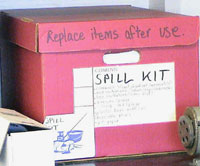
- Help anybody that might be contaminated by flushing the area splashed. The safety shower, eye wash unit, or the sink can be used for this purpose.
- Inform persons in the vicinity of the spill. Evacuate all nonessential personnel from the spill area, and post danger signs.
- Always use rubber gloves and tweezers to pick up broken glass. Dispose of glass and sharps in specially marked, puncture-proof containers.
- If the material spilled is flammable, turn off ignition sources.
- Avoid breathing vapors by opening windows or running the fume hoods.
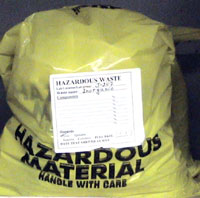
- Consult reference literature to learn more about the dangers associated with the substance and the right procedure to clean up the spill.
- Use the materials and instructions in your spill kit to clean the spill.
- Wash your hands and any other areas such as shoe soles that could have been contaminated.
- Report incident to the laboratory supervisor and the Safety Office at extension 7280, or 1-508-793-7280.
- If the substance spilled was hazardous, the waste produced will be considered hazardous waste and will have to be brought to the safety office for disposal within 72 hours.
Shock victims must be removed immediately from the source of electricity. To protect yourself, first turn the power off or use a non-conductive item such as a wooden stick to move the person away. Keep the victim lying down with feet elevated until help arrives. For help, call Campus Police at extension 7575, or 1-508-793-7575.
Oxygen, heat, and fuel are necessary for the chemical reaction that produces a fire. These three things form what is called the fire triangle. Take one of these three things away and the fire can be extinguished. Explosions are followed by a fire. Use fire emergency procedures in the event of a fire.
Fuels
Fuels are classified into the following four categories:
- Class A
Solid combustible materials that are not metals: wood, paper, cloth, trash, plastics. - Class B
Flammable liquids: gasoline, oil, grease, acetone. Any non-metal in a liquid state, on fire. - Class C
Electrical: energized electrical equipment. As long as it’s “plugged in,” it would be considered a class C fire. - Class D
Metals: potassium, sodium, aluminum, magnesium. It takes special extinguishing agents (Metal-X, foam) to fight such a fire.
How to Use a Fire Extinguisher
To use a fire extinguisher, remember the acronym PASS, which stands for Pull, Aim, Squeeze, and Sweep. Always use an extinguisher that is appropriate for the fuel type.
Here is an excellent resource for understanding the proper technique.
If the medical emergency requires minor medical treatment, use the materials and instructions provided in your first aid kits. Replacements for the kit can be obtained at the chemistry stockroom (S-310): extension 7511 or 1-508-793-7511.
Information on emergencies regarding chemical or biological splashes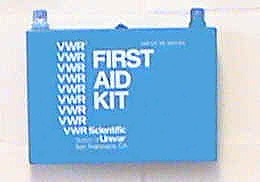
Major Medical Emergencies Basics
If a major emergency takes place, please try not to panic and remember not to move the injured person unless there is danger of further harm. Call University Police for assistance: extension 7575, or 1-508-793-7575. Give as much detail as possible about injuries and location of the victim. Always keep the victim warm until helps arrives, and ask somebody nearby to meet and guide the ambulance crew.
How to Use a Safety Shower
- Place person under the shower head and pull the chain.
- Call University Police for medical help: extension 7575 or 1-508-793-7575.
- Put on a pair of gloves and remove all the person’s clothes, shoes, and jewelry.
- Let the water run for at least 15 minutes.
- Cover the victim with a blanket.

How to Use an Eye Wash Unit
- Approach the nearest eye wash unit.
- Open eyelids widely to ensure effective washing.
- Flush the eyes and eyelids from the nose to the ear for at least 15 minutes or until the Emergency Medical Service (EMS) arrives.
- Cover the eyes with gauze.
- If not contacted yet by somebody else, call University Police for medical help: extension 7575 or 1-508-793-7575.
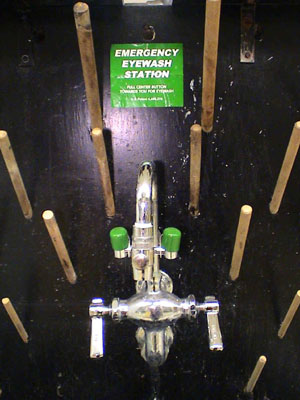
Gas Cylinder Safety
- Always read the label and consult SDS.
- Clearly mark cylinders as “Full,” “Empty,” and “In use” as it applies.
- Screw-on cap must be placed when cylinders are not in use.
- Secure cylinders at all times to prevent tipping.
- Never attempt to repair a cylinder or valve.
- Always make sure that regulator and fittings are compatible.
- Use a properly designed wheeled cart to move cylinders. Never roll or drag them.

Leaking Gas Cylinders
If a leaking cylinder is discovered, move it to a safe place (if it is safe to do so — when in doubt, call the Safety Office x7280) and inform the chemical safety officer.
NEVER attempt to repair a cylinder or valve.
Cylinders in Storage
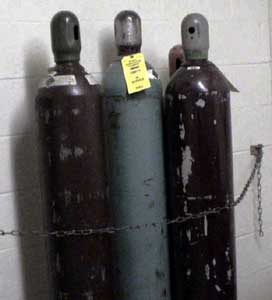
A Cylinder in Use
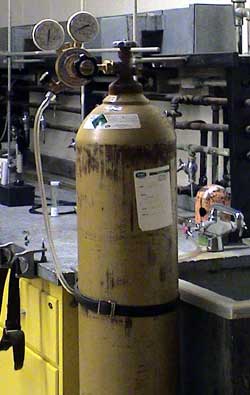
Environmental Health and Safety
Arthur M. Sackler Sciences Center
Room S108
Worcester, MA 01610
1-508-793-7280
1-508-793-7117
Chemical Safety Officer, ehs@clarku.edu

